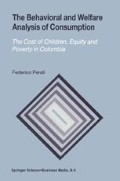Abstract
Cross-section household expenditure data often involve positive as well as zero purchases. The behavioral information contained in the observations with zero expenditures has significant econometric as well as economic implications. It is the manifestation of a choice that needs to be explained. Pudney (1989) remarks that imposing non-negativity as a mere feature of the stochastic specification is not satisfactory since it does not provide a convincing explanation of the process generating zeroes. Pudney enunciates at least three mechanisms. A person may not purchase a particular good because the survey period is too short, or may not consume simply because she/he could not find the desired good, or the observed zero is the outcome of a free choice. Pudney (1990) refers to this last alternative as “economic nonconsumption.” The individual deliberately chooses not to consume the good given his current budget and the prices she/he faces. This behavior represents a genuine corner solution of the individual’s utility maximization problem represented in a Kuhn-Tucker framework, or using a Tobit model for censored regression.
Access this chapter
Tax calculation will be finalised at checkout
Purchases are for personal use only
Preview
Unable to display preview. Download preview PDF.
Notes
The first income class groups the households below or at the indigence line. The second income class includes households with income ranging between the indigence line and the poverty line. The other classes have been defined maintaining as a range the distance between the indigence and the poverty line. Both lines are as estimated by the National Administrative Department of Statistics (DANE) of Colombia in conformity with the definition provided by the Economic Commission for Latin America (CEPAL).
This evidence contrasts with the case purported by Blundell and Meghir (1987) who do not consider zero expenditures on clothing as corner solutions. It must be emphasized that these authors use the UK Family Expenditure Survey which, besides describing an affluent society, has no recall.
The non-parametric regressions reported here use the Gaussian kernel (Härdle 1990) with a bandwidth chosen by visual inspection of several trials.
Another factor critical in making expenditure differ from consumption, especially likely in a developing country context, is the problem of errors in measurement and misreporting. Failure to correct for this possible source generating zero expenditures would contaminate this interpretation as corner solutions. The classic solution to this problem is to resort to instrumental variable estimation. The White-heteroskedasticity consistent OLS estimates are available from the author upon request. The instruments for the logarithm of total expenditure are the logarithm of the price for food (LPFOOD), the price for housing (LPVIV), and the price of other goods (LPOTROS), the logarithm of income (LNY), its squared term (LNY2) and an interaction term between log-income and the number of children in the household. The set of socio-economic characteristics is fairly exhaustive. Less than 30 percent of the parameters are not significantly different from zero. The results are comparable, both in magnitude and significance, to the instrumented expenditure estimated by Blundell, Pashardes and Weber (1993).
The group of childless couples does not include couples of elders of more than 56 years of age because of their relative position in the life cycle and their differential cost structure.
The price, income, translating, and scaling parameter estimates for the estimation with and without the IB property imposed are available upon request. The impact of the economic variables, and of both translating and scaling demographic effects, is generally significantly different from zero at the 10 percent level of significance.
The first income class groups the households below or at the indigence line (C 1). The second income class includes households with income ranging between the indigence line and the poverty line. The other classes have been defined maintaining as a range the distance between the indigence and the poverty line. Both lines are as estimated by the National Administrative Department of Statistics (DANE) of Colombia in conformity with the definition provided by the Economic Commission for Latin America (CEPAL).
Author information
Authors and Affiliations
Rights and permissions
Copyright information
© 2003 Springer Science+Business Media Dordrecht
About this chapter
Cite this chapter
Perali, F. (2003). Estimation of a Censored Demand System. In: The Behavioral and Welfare Analysis of Consumption. Springer, Boston, MA. https://doi.org/10.1007/978-1-4757-3729-5_4
Download citation
DOI: https://doi.org/10.1007/978-1-4757-3729-5_4
Publisher Name: Springer, Boston, MA
Print ISBN: 978-1-4419-5374-2
Online ISBN: 978-1-4757-3729-5
eBook Packages: Springer Book Archive

